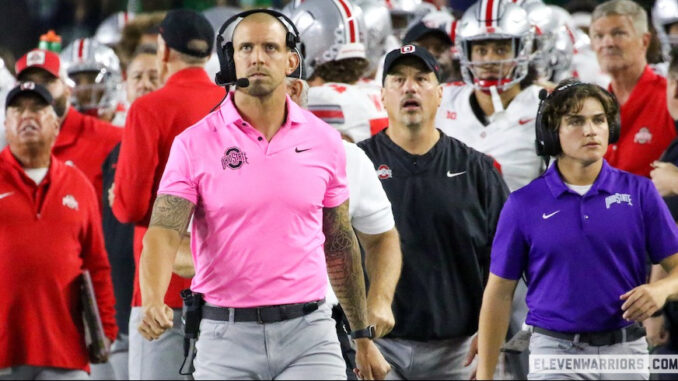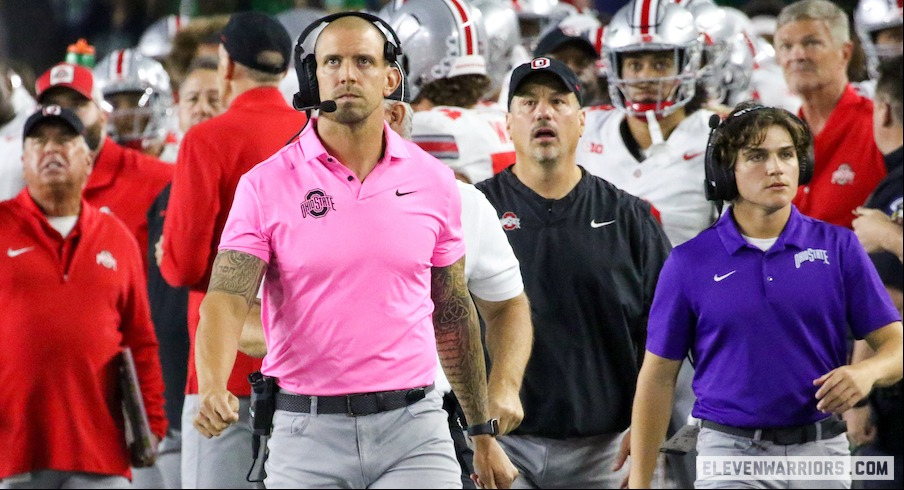
JAMES LAURINAITIS IN FAVOR OF COLLEGE FOOTBALL HELMET COMMUNICATION AFTER EXPERIENCING GAME WITH AND WITHOUT IT.
As college football draws closer to permitting helmet communications in games, new Ohio State linebackers coach James Laurinaitis sees personally how this could make it easier for coaches and players to communicate during games.
During his NFL career, Laurinaitis frequently wore the “green dot” helmet as a middle linebacker for the St. Louis Rams, which allowed him to communicate directly with the coaches on the sidelines. He feels helmet communication will benefit college football.
“I love the helmet speakers,” Laurinaitis stated on Tuesday.
Laurinaitis learned the hard way during his two years as a graduate assistant at Notre Dame and Ohio State how difficult it can be for coaches to signal plays from the sideline. Last year, Laurinaitis assisted the Buckeyes in changing their signals to combat opponents’ sign-stealing efforts, a job that gained attention due to the NCAA investigation into Michigan’s operation.
One of the main reasons Laurinaitis is happy about his elevation to linebackers coach is that he will be able to focus on instructing his position group during games rather than sending signals.
“That’s stressful, man,” Laurinaitis explained. “And obviously, for a big reason, with a lot of the well-publicized stuff around signaling in our conference, I think it’s very stressful…” I mean, you’re talking about week after week of changing signals, which took up a lot of your time. You became an expert in sign language during some of these calls.
“When I’m signaling, I’m sitting there, waiting to see what (defensive coordinator Jim Knowles) would call next. I didn’t have time to process what happened on that play, right? You had to separate coaching from signaling. I believe that just by being able to coach, I will have a much greater sense of ‘OK, what are the plays that are actually happening?’ Because that’s a lot to deal with when there are three, sometimes five signalers up and people are confused about who’s active and who’s not.”
Such diversions may become less essential if the NCAA permits the use of helmet communications in games this season.According to Chris Vannini of The Athletic, the NCAA Football Rules Committee is set to propose allowing teams to use helmet communication and sideline tablets during games at their upcoming meeting.
The NCAA authorized teams to use helmet communication in non-playoff bowl games this season as a test run, which was deemed a success. Although Ohio State and Missouri agreed not to employ the technology in the Cotton Bowl, Ryan Day said at the time that he supported using helmet communication for the 2024 season.
“Down the road, it makes a lot of sense,” Day stated before the Cotton Bowl. “To try to manage a game without having done it all season, we felt like it was probably something we wanted to have a spring practice and a preseason to work through.”
It is currently unclear how many players will be able to utilize the helmets at once if helmet communication is approved. The NFL now only allows the quarterback and one defensive player to have speakers in their helmets; if the NCAA follows suit, the inclusion of helmet communication would not eliminate the necessity for signaling, particularly in fast-paced scenarios.
It might, however, help coaches communicate with their players more quickly and reduce sign-stealing by opponents, which is why many coaches, including Ohio State’s newest assistant, support introducing the technology to the college game.
“You’re still gonna have to have signals because of the tempo, and you can imagine in the Shoe, if the crowd’s getting into it and it’s second down and they go tempo on third down, you can communicate it in,” Laurinaitis said in a statement. “Now it depends on whether they’re going to give them to just Mike or the entire defense. A lot of it needs to be worked out. Because in the NFL, it’s a green dot representing one player. So you (the guy wearing the helmet) would receive the call, and it would be your responsibility to indicate or yell it to the rest of the defense.
“I know that during bowl games, some teams had it set up so that the entire defense had the microphone. That would be fantastic, because it would certainly prevent a lot of sign theft and other incidents.”

Leave a Reply